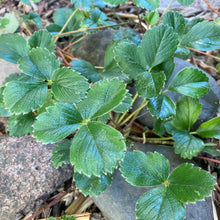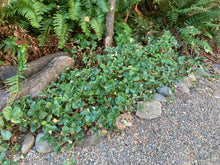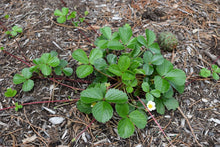Fragaria chiloensis
Coastal, or beach strawberry is naturally found all along the coastal regions of the Pacific NW, often seen around dunes and grasslands adjacent to the beach. In Metro area gardens coastal strawberry has proven to be a great option for an easy-to-grow, hardy groundcover with shiny tough evergreen leaves, white flowers in spring and summer that attract and support pollinators, and the ability to quickly form lush mats of greenery. Despite being a parent of modern cultivated strawberries, you may rarely see the very small fruits on this native in a garden setting. If you do, the seedy fruit is enjoyed by birds and small mammals considerably more than by people!
- Plant type/canopy layer: evergreen, perennial, herbaceous plant
- Size at maturity: 1-10” tall, 3-5” clumps with runners that will continuously spread
- Light requirements: full sun to partial shade
- Moisture requirements: dry to moist soil
- Bloom time: depending on location, blooms can be seen in most any month - though in Portland metro area the are most commonly seen April - July
- Growth rate/ease: moderate to fast growth rate, very easy to grow, spreads by runners
- Wildlife support: flowers attract and provide nectar to adult butterflies, bees and other insect pollinators; fruits are eaten by birds and small mammals; overall plant attracts and supports beneficial and other pest eating insects and is a caterpillar host plant and larval food source for native butterflies and moths such as a Two-banded Checkered-skipper and the Alfalfa Lopper Moth
- Native habitat/range: found in coastal communities throughout the Pacific Northwest. Portland Plant List - no.
- Special features & uses: groundcover; evergreen; drought-tolerant; deer resistant; edible (though not particularly delicious); medicinally it has been used as an antiseptic and astringent, to help regulate the menstrual cycle, to boost lactation and treat toothaches and burns; landscape uses include meadowscapes, pollinator gardens, rock gardens, erosion-control and green roofs; it is also a dynamic accumulator, meaning it can gathering minerals or nutrients from the soil and store them in it's leaves where they become more available to use as a fertilizer or to improve mulch
Gardening with Coastal Strawberry: Add coastal strawberries to fill in open dry areas in full sun or part sun locations where you are looking to create an evergreen carpet below shrubs or trees, along garden edges or in rock gardens. Coastal strawberries prefer sandy or loose soils and are very hardy and exceptionally drought-tolerant. They can be left to fend for themselves, but for faster growth, consider adding compost and extra water to help them take off. Coastal strawberries will spread vigorously by runners. Initial plantings every foot or so will spread to create a full covered mat of greenery within a couple of growing seasons. Easy to propagate in early spring by separating new plants from the runners and transplanting.
Photo Credits 1, 2: Tracy Cozine, Sparrowhawk Native Plants
Photo Credit 3: Nikkie West, Sparrowhawk Native Plants






